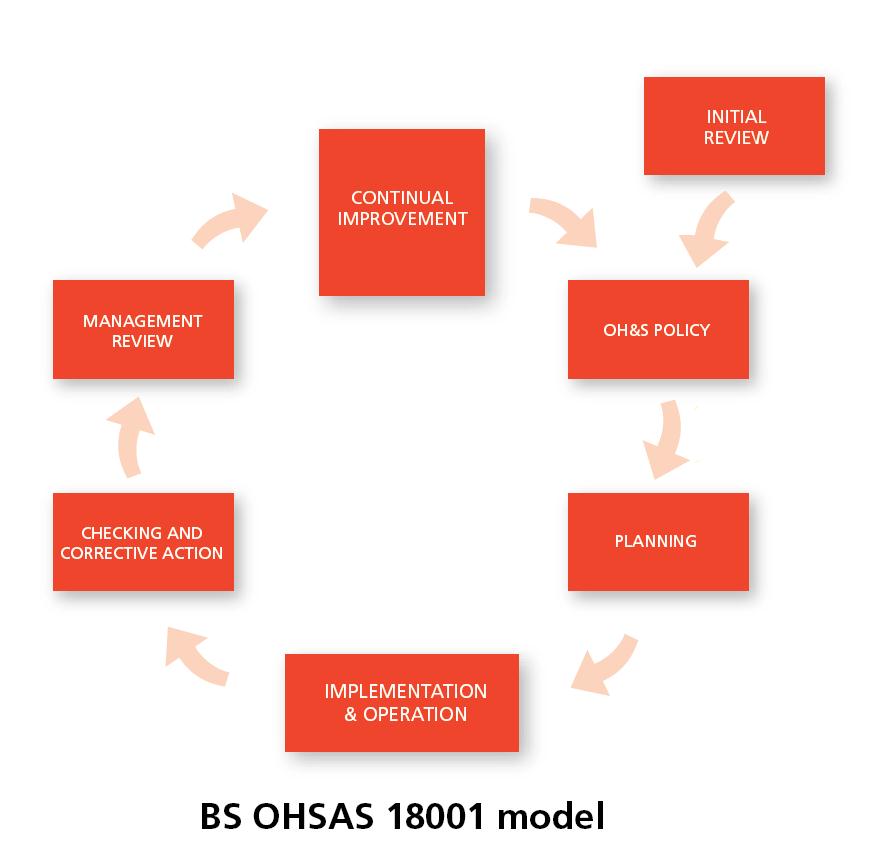The implementation of an OHSMS is now a legal requirement in many countries allowing compliance with legislation and protecting you and your organisation. BS OHSAS 1800 (The British Standard identical to OHSAS 18001:2007) provides organisations with a structured approach to planning, implementing and managing an OHSMS.
Many aspects of BS OHSAS 18001 seem optimum and well suited to the simplification of the UK's health and safety culture that our government is looking for.
A prime example being the HSE being urged to create simpler risk assessment procedures for so-called ‘low hazard’ workplaces such as offices and shops whereby creation of ‘periodic checklists’ enabling businesses ‘to check and record their compliance with regulations’ to take place frequently. BS OHSAS 18001 already assists organisations to build the necessary procedures for oversight such as these into daily operations emphasizing the importance of continual monitoring and improvement.
Another example is the importance of raising standards with a call to ‘professionalise health and safety consultants’ by accreditation through a validation process.’ BS OHSAS 18001 has its own audit and certification processes and has long stressed the value of this external recognition of standards, providing reassurance that compliance is fit for purpose.
A survey* carried out by the OHSAS Project Group (2009) in relation to global certification to OHSAS 18001 showed that:
- 116 countries across the globe implement the system
- 54,357 is the total number of OHSAS 18001 (or equivalent) certificates reported globally
- Countries reporting the largest number of certificates were China, New Zealand, Czech Republic, Italy, Spain, United Kingdom, Australia, Germany, and Japan
Some believe this global interest could be due to a need for representation of the trade relations between these countries and the UK. As well as an increase in demand for certification from an organisations supply chain fulfilling a core aspect of their CSR program.
Is the perception that the momentum will continue rapidly and OHSAS 18001 will become a de facto standard worldwide that major companies will need to have?
Are there other hidden benefits other than creating a safer workplace and reducing costs of accidents?
Some believe the system can be used towards global benchmarking, global reporting, corporate governance, insurance premium negotiations and using certification to win new clients, etc.
* Please note that these figures are estimated to be 15-20% light in that one of the major global certification bodies failed to respond to the survey. It's Ark’s understanding that the OHSAS Project Group intend to carry out another survey this year which will provide us with some up-to-date data around the global growth of certification to this standard (or equivalent national standards aligned with OHSAS 18001) which Ark will we share with members of Ark’s LinkedIn Group.
Features and benefits of BS OHSAS 18001*
- A safer workplace that has identified hazards, assessed risks and mitigating against them
- Stakeholder confidence by confirming that your organisation has met a number of legal and regulatory requirements
- Morale by illustrating a clear commitment to safety
- Reduced costs with fewer accidents and improvements to your insurance liability
- Training highlighting whether your employees are competent
- Monitoring with regular assessments allowing continuous improvement
- Integrated with other management systems i.e. ISO 9001 & ISO 14001
*(Occupational Health & Safety Management, BSI Management Systems, 2007. Product Guide. Minimising Your Health & Safety Risks , BSI/UK/13/MS/1208/E/CW, 6).

Ark Workplace Risk Ltd helps organisations design and implement BS OHSAS 18001 using best in class methodologies and Ark’s own research.
For initial discussions please contact David Hills, Associate Director